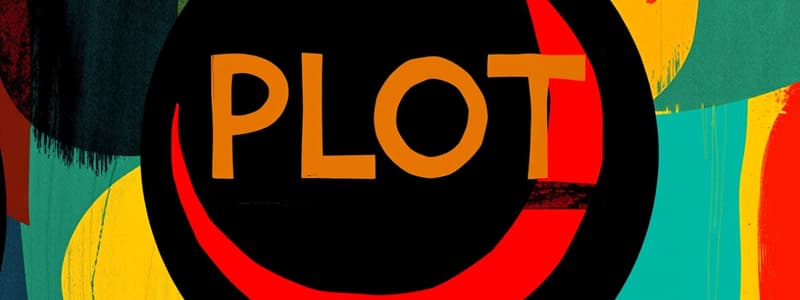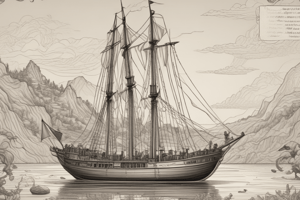Podcast
Questions and Answers
What is defined as the organized pattern or sequence of events that make a story?
What is defined as the organized pattern or sequence of events that make a story?
- Conflict
- Plot (correct)
- Mood
- Theme
Which element describes the vantage point from which the story is told?
Which element describes the vantage point from which the story is told?
- Conflict
- Theme
- Setting
- Point of view (correct)
What term refers to the dramatic struggle between two forces in a story?
What term refers to the dramatic struggle between two forces in a story?
- Mood
- Character
- Conflict (correct)
- Tone
What encompasses the time and place where a story occurs?
What encompasses the time and place where a story occurs?
Which element conveys the writer's attitude toward the audience or the subject matter?
Which element conveys the writer's attitude toward the audience or the subject matter?
What is primarily responsible for creating the general atmosphere of a story?
What is primarily responsible for creating the general atmosphere of a story?
Which element serves as the main idea or central message of a story?
Which element serves as the main idea or central message of a story?
Which element is crucial for establishing the circumstances under which the story unfolds?
Which element is crucial for establishing the circumstances under which the story unfolds?
What term describes the struggle between opposing forces in a narrative?
What term describes the struggle between opposing forces in a narrative?
Which factor influences the writer's attitude expressed through the choice of words and dialogue?
Which factor influences the writer's attitude expressed through the choice of words and dialogue?
Flashcards are hidden until you start studying
Study Notes
Literary Elements
- Plot: Represents the structured sequence of events that form the narrative, detailing how the story unfolds.
- Point of View: Refers to the perspective from which the story is narrated, influencing how readers perceive the events and characters.
- Setting: Establishes the time and place of the story, providing context and backdrop for the narrative's events.
- Characters: Encompasses all participants in the story, including humans, animals, or objects that contribute to the plot.
- Conflict: Defines the central struggle between opposing forces which drives the narrative forward; essential for creating drama and engaging the reader.
- Theme: The overarching message or idea that the story conveys, often reflecting broader societal or universal issues.
- Mood: Represents the emotional atmosphere or environment created by the text, influencing the reader's feelings and experience.
- Tone: Indicates the author's attitude toward the subject, characters, or audience; shaped through word choice (diction) and dialogue.
Literary Elements
- Plot: Represents the structured sequence of events that form the narrative, detailing how the story unfolds.
- Point of View: Refers to the perspective from which the story is narrated, influencing how readers perceive the events and characters.
- Setting: Establishes the time and place of the story, providing context and backdrop for the narrative's events.
- Characters: Encompasses all participants in the story, including humans, animals, or objects that contribute to the plot.
- Conflict: Defines the central struggle between opposing forces which drives the narrative forward; essential for creating drama and engaging the reader.
- Theme: The overarching message or idea that the story conveys, often reflecting broader societal or universal issues.
- Mood: Represents the emotional atmosphere or environment created by the text, influencing the reader's feelings and experience.
- Tone: Indicates the author's attitude toward the subject, characters, or audience; shaped through word choice (diction) and dialogue.
Studying That Suits You
Use AI to generate personalized quizzes and flashcards to suit your learning preferences.




